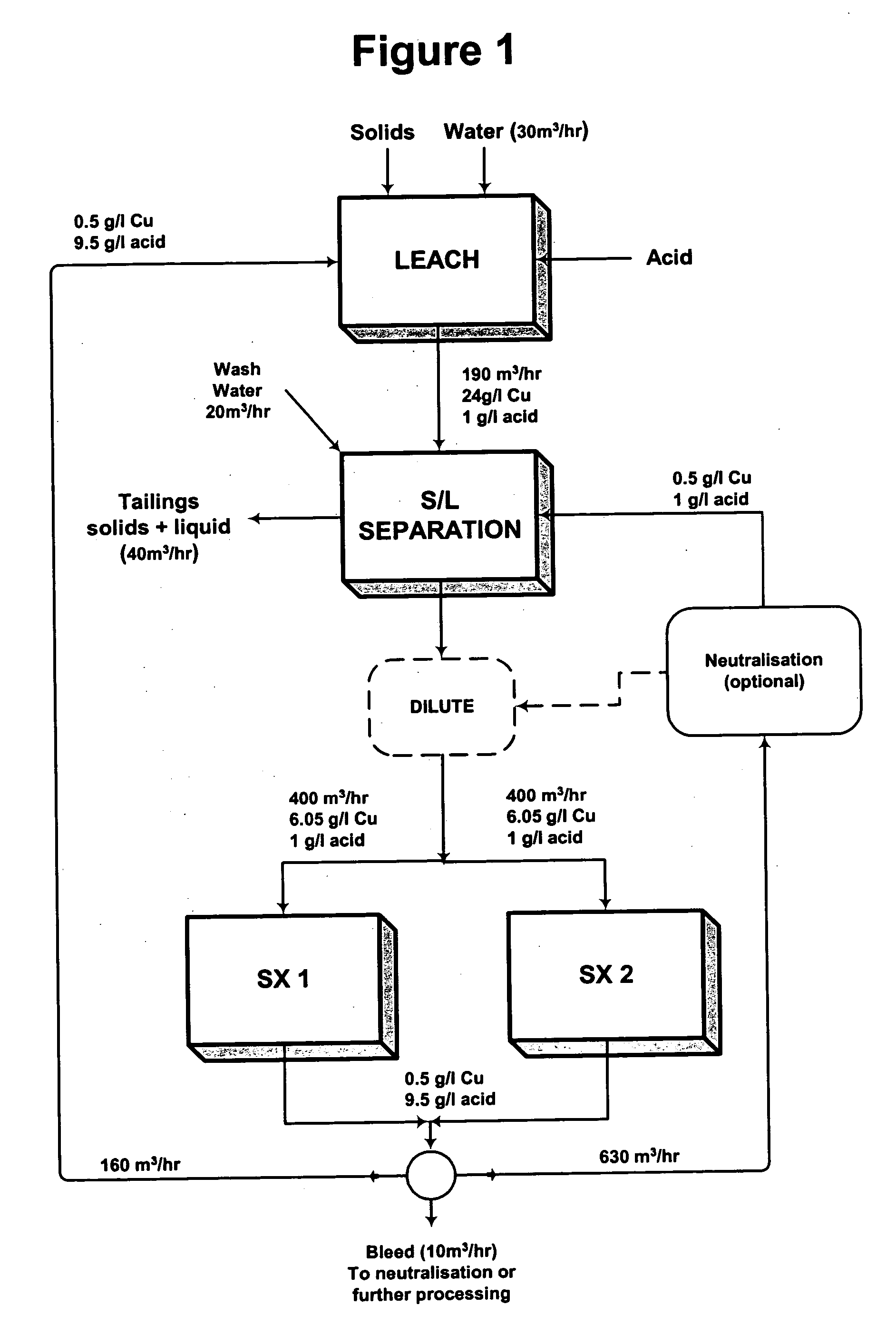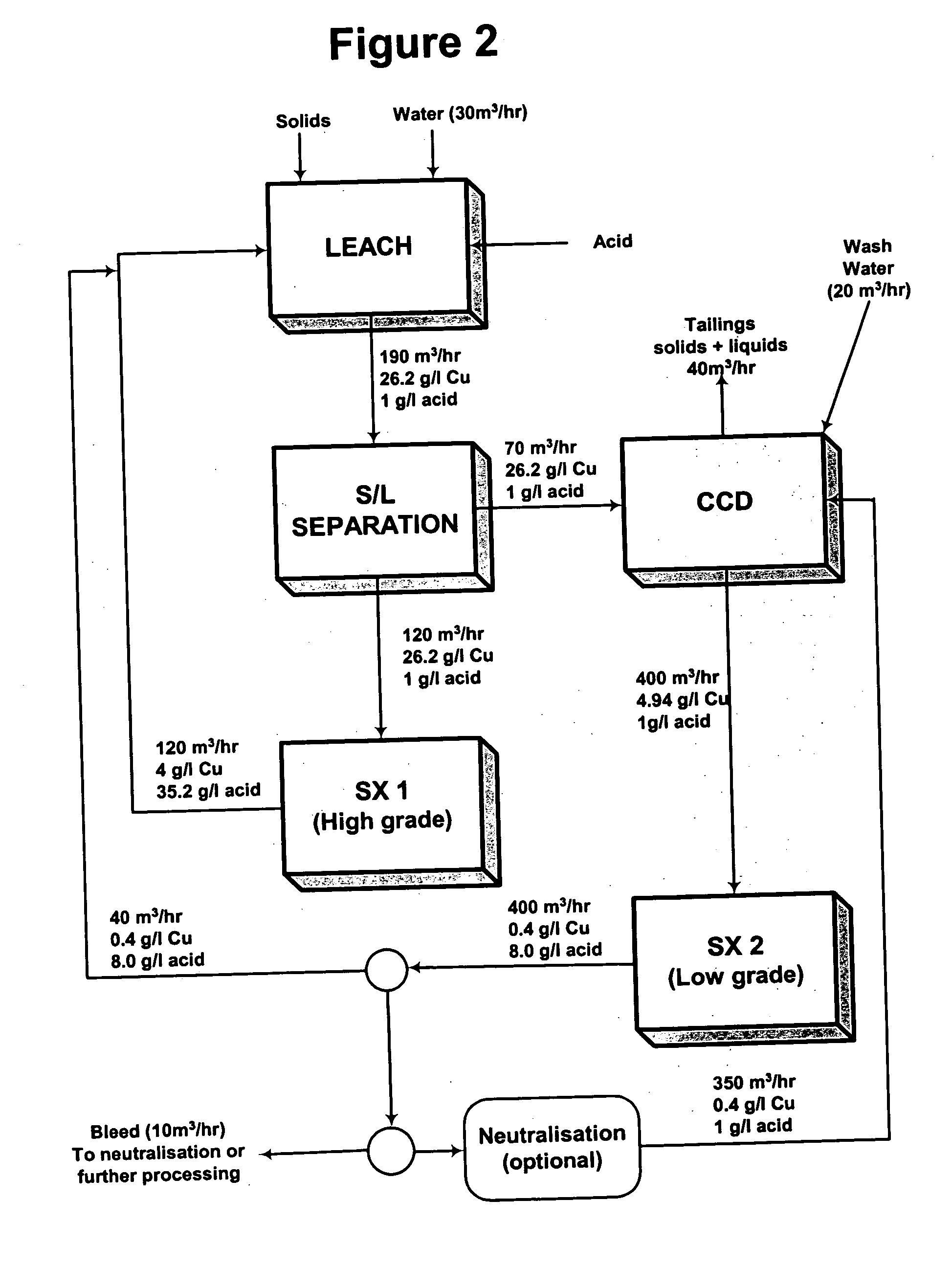Methods for improving the recovery of metal leaching agents
a technology of leaching agent and recovery method, which is applied in the direction of solvent extraction, dissolving, separation process, etc., can solve the problems of increasing the cost of operation, reaction becoming self-limiting in equilibrium, etc., and achieve the effect of improving the recovery of leaching agen
Inactive Publication Date: 2005-02-10
COGNIS IP MANAGEMENT GMBH
View PDF8 Cites 23 Cited by
- Summary
- Abstract
- Description
- Claims
- Application Information
AI Technical Summary
Benefits of technology
[0008] It has been surprisingly discovered that by splitting an aqueous leach solution into two or more portions and subjecting at least one portion to solvent extraction prior to any significant dilution and also subjecting at leas
Problems solved by technology
During solvent extraction as the metal is extracted, acid concentration builds in the aqueous phase and the reaction becomes self-limiting in equilibrium.
Unfort
Method used
the structure of the environmentally friendly knitted fabric provided by the present invention; figure 2 Flow chart of the yarn wrapping machine for environmentally friendly knitted fabrics and storage devices; image 3 Is the parameter map of the yarn covering machine
View moreImage
Smart Image Click on the blue labels to locate them in the text.
Smart ImageViewing Examples
Examples
Experimental program
Comparison scheme
Effect test
 Login to View More
Login to View More PUM
| Property | Measurement | Unit |
|---|---|---|
| Fraction | aaaaa | aaaaa |
| Fraction | aaaaa | aaaaa |
| Fraction | aaaaa | aaaaa |
Login to View More
Abstract
Processes for metal leaching/solvent extraction are described which comprise: (a) providing a first aqueous leach pulp which comprises a mixture of leached solids and an aqueous leach solution comprising a metal, a leaching agent and water; (b) subjecting the first aqueous leach pulp to a first solid-liquid separation to provide a first clarified aqueous leach solution and a second aqueous leach pulp, wherein the second aqueous leach pulp comprises the leached solids at a % solids level greater than the first pulp; (c) subjecting the first clarified aqueous leach solution to a first solvent extraction prior to any significant dilution, whereby a first aqueous raffinate is obtained; (d) subjecting the second aqueous leach pulp to a second solid-liquid separation with dilution via an aqueous stream to obtain a second clarified aqueous leach solution; and (e) subjecting the second clarified aqueous leach solution to a second solvent extraction whereby a second aqueous raffinate is obtained.
Description
CROSS-REFERENCE TO RELATED APPLICATIONS [0001] This application claims priority, under 35 U.S.C. §119(e), of U.S. Provisional Patent Application No. 60 / 491,311, filed on Jul. 30, 2003, the entire contents of which are hereby incorporated by reference.BACKGROUND OF THE INVENTION [0002] Most metals are obtained by removing those metal values from the ores in which they are found in the ground. Once the ore has been mined, the metal must then be separated from the remainder of the ore. One method to separate the metal from the ore is known as leaching. In general, the first step in this process is contacting the mined ore with an aqueous solution containing a leaching agent which extracts the metal from the ore into solution. For example, in copper leaching operations, such as, for example, in the agitation leaching of copper oxide ores, sulfuric acid in an aqueous solution is contacted with copper oxide minerals. During the leaching process, acid in the leach solution is consumed and ...
Claims
the structure of the environmentally friendly knitted fabric provided by the present invention; figure 2 Flow chart of the yarn wrapping machine for environmentally friendly knitted fabrics and storage devices; image 3 Is the parameter map of the yarn covering machine
Login to View More Application Information
Patent Timeline
 Login to View More
Login to View More IPC IPC(8): B01D11/00C22BC22B3/26C22B11/08C22B15/00C22B19/00C22B23/00
CPCC22B3/0005C22B15/0084C22B15/0071C22B15/0065Y02P10/20C22B3/26
Inventor KORDOSKY, GARY A.NISBETT, ANDREW
Owner COGNIS IP MANAGEMENT GMBH
Features
- R&D
- Intellectual Property
- Life Sciences
- Materials
- Tech Scout
Why Patsnap Eureka
- Unparalleled Data Quality
- Higher Quality Content
- 60% Fewer Hallucinations
Social media
Patsnap Eureka Blog
Learn More Browse by: Latest US Patents, China's latest patents, Technical Efficacy Thesaurus, Application Domain, Technology Topic, Popular Technical Reports.
© 2025 PatSnap. All rights reserved.Legal|Privacy policy|Modern Slavery Act Transparency Statement|Sitemap|About US| Contact US: help@patsnap.com


